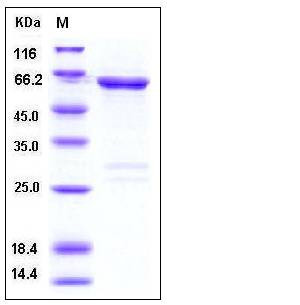Human ACK1 / TNK2 Protein (GST Tag)
ACK,ACK-1,ACK1,p21cdc42Hs
- 100ug (NPP3555) Please inquiry
| Catalog Number | P11080-H09B |
|---|---|
| Organism Species | Human |
| Host | Baculovirus-Insect Cells |
| Synonyms | ACK,ACK-1,ACK1,p21cdc42Hs |
| Molecular Weight | The recombinant human ACK1/GST chimera consists of 592 amino acids and predicts a molecular mass of 68 kDa. It migrates as an approximately 62 kDa band in SDS-PAGE under reducing conditions. |
| predicted N | Met |
| SDS-PAGE |  |
| Purity | > 90 % as determined by SDS-PAGE |
| Protein Construction | A DNA sequence encoding the amino acid (Gly 110-Trp 476) of human ACK1 isoform 1 (NP_005772.3) was expressed with the GST tag at the N-terminus. |
| Bio-activity | |
| Research Area | Signaling |Signal Transduction |Nuclear signaling |Nuclear hormone receptors |Testosterone |
| Formulation | Supplied as sterile 20mM Tris, 500mM NaCl, pH 7.4, 10% glycerol, 0.5mM EDTA, 0.5mM PMSF, 0.5mM TCEP 1. Normally 5 % - 8 % trehalose and mannitol are added as protectants before lyophilization. Specific concentrations are included in the hardcopy of COA. |
| Background | ACK1 (also known as ACK, TNK2, or activated Cdc42 kinase) is a structurally unique non-receptor tyrosine kinase that is expressed in diverse cell types. This downstream effector of CDC42 which mediates CDC42-dependent cell migration via phosphorylation of BCAR1. The ACK1 protein may be involved in a regulatory mechanism that sustains the GTP-bound active form of Cdc42Hs and which is directly linked to a tyrosine phosphorylation signal transduction pathway. ACK1 integrates signals from plethora of ligand-activated receptor tyrosine kinases (RTKs), for example, MERTK, EGFR, HER2 and PDGFR to initiate intracellular signaling cascades. It binds to both poly- and mono-ubiquitin and regulates ligand-induced degradation of EGFR. ACK1 transduces extracellular signals to cytosolic and nuclear effectors such as the protein kinase AKT/PKB and androgen receptor (AR), to promote cell survival and growth. ACK1 participates in tumorigenesis, cell survival, and migration. Gene amplification and overexpression of ACK1 were found in many cancer types such as those of the lung and prostate. Recently, four somatic missense mutations of ACK1, which occur in the N-terminal region, the C-lobe of the kinase domain, and the SH3 domain, were identified in cancer tissue samples. |
| Reference |
